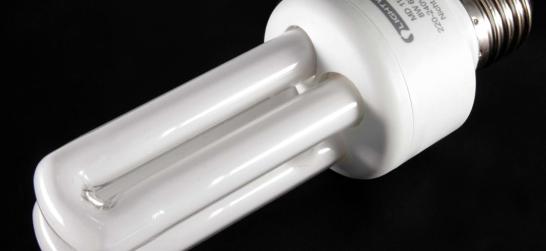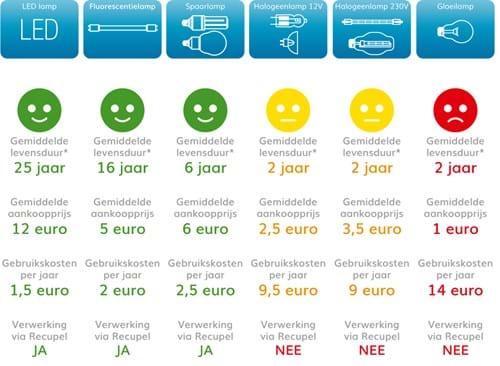Recupel also takes on the collection and recycling of gas discharge bulbs (energy efficient bulbs and tube bulbs) and LED lamps.

What are the bulbs in question?
The official name for an energy efficient bulb is a compact fluorescent lamp. This is actually the sister of the fluorescent tube (the tube lamp, such as the known TL lamp). Both work on the principle of gas discharge. This is in contrast to incandescent and halogen bulbs that emit light through a filament.
Each type of bulb has specific characteristics, advantages and disadvantages:
Where to go?
To the recycling centre
The rule is: do not dispose of bulbs in regular glass containers or with the household waste, but take them to the recycling centre, together with the discarded luminaires.
Bulbs contain mercury and are therefore considered Small Hazardous Waste (KGA). Handle them with care and, more importantly, do not break them, because safety comes first. The park rangers will also thank you. Just bring them to the KGA booth or dispose of them carefully in the right lamp container. This is completely free of charge.
Here you can find recycling centres in your area.
In the store
When buying a new bulb and/or luminaire, you may also leave the old discarded bulbs in the store.
You can also go to a Recyclepoint nearby.
Good to know
How are they processed?
The method of processing depends on the quality and the shape of the bulbs. For example, the bulbs are separated into different grades of glass, different types of fluorescent powder and different types of metal. Both the reusable fluorescent powder as well as the finely ground glass of the best quality is used as raw material in the production of new bulbs. The glass of inferior quality is directed towards other destinations, such as the glass fibre industry, incineration and melting furnaces etc. The metal is recycled, and the fluorescent powder that does not qualify for reuse is removed from our environment in an environmentally responsible manner.
What if you break an energy saving bulb?
In normal use, the mercury present in the energy efficient bulb cannot escape from the closed lamp tubes, and thus is not dangerous. If the bulb breaks, there is a risk that you can come into contact with hazardous substances. So be very careful when you clean up a damaged energy efficient bulb. The new European Ecodesign Directive requires that each bulb manufacturer posts information on its website about how a damaged lamp must be cleaned up.
Method to clean up a damaged energy efficient bulb:
- Step 1: Open the windows, and leave the room for at least fifteen minutes
- Step 2: Use disposable gloves and sweep the pieces together with a small hand brush. Do not use a vacuum cleaner!
- Step 3: Sweep all the shards and powder together on a piece of paper and throw everything into a resealable plastic bag
- Step 4: Take the plastic bag with all the remnants of the damaged lamp to the recycling centre
- Step 5: Insert the hand duster and disposable gloves into a sealed plastic bag and throw the bag into the normal rubbish bin.
- Step 6: Wash your hands carefully
An energy saving bulb with a second shell provides extra security. The second shell is usually made from a non-breakable plastic instead of glass. The efficiency of such a bulb with a second shell is on average 10% lower than that of a naked energy saving bulb.
How much does a household that switches to energy efficient lighting save per year?
On average between €25 and €50 per year. Or a total annual savings of 800,000 tonnes of CO2, once nobody in Belgium uses a regular bulb anymore.
How much longer does an energy efficient bulb last compared to an incandescent bulb?
An energy efficient bulb is either a compact fluorescent lamp or an LED lamp. A normal energy efficient bulb has a lifetime of at least 6,000 (compact fluorescent lamp) up to 30,000 hours. That's up to 30 times longer than an incandescent bulb.
Are energy efficient bulbs more expensive than incandescent bulbs?
You will earn back the extra cost of the purchase quickly. 1 100 W incandescent bulb is replaced by an energy efficient bulb of 20 W = a saving of up to €100 (15 euros / year).
How many kilos of energy efficient bulbs, LED's and neon bulbs did Recupel collect in 2010?
In 2010, Recupel collected no less than 1,299,000 pounds kilos in bulbs.
What energy labels do most energy efficient bulbs have?
Bulbs are labeled from A to G. Only a bulb with energy label A may call itself an energy efficient or CFL bulb.

